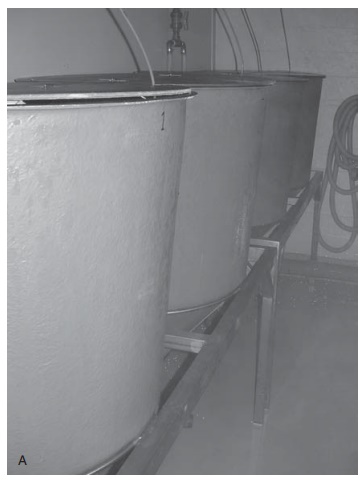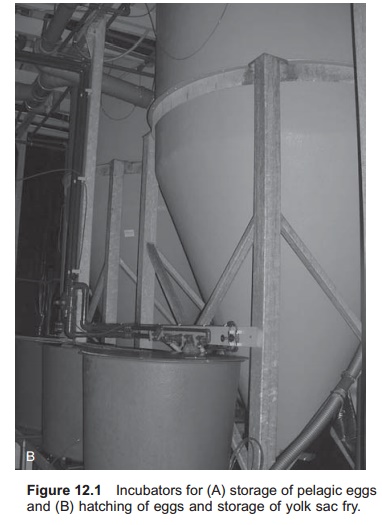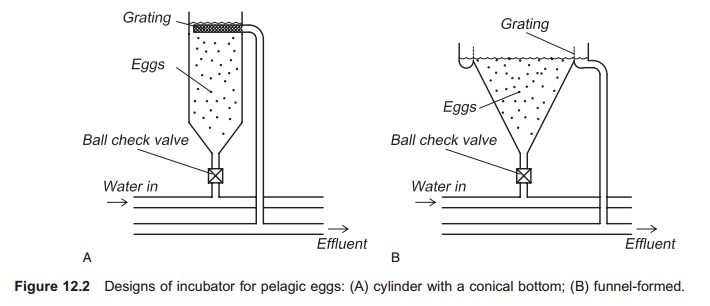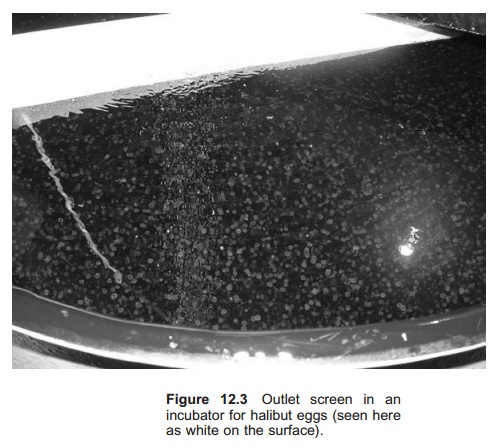Chapter: Aquaculture Engineering : Egg Storage and Hatching Equipment
Systems where the Fish eggs stay pelagic in Aquaculture Engineering
Systems where the eggs stay pelagic
Two production methods are commonly used for pelagic eggs, which may influence the design of the incubator. Either the eggs stay in the same unit until hatching is finished, or there is a two-step process using two separate units where the eggs are removed before hatching. In both units the eggs stay pelagic (Fig. 12.1). The normal difference is the size of the incubators; for the second step large units with volume of several cubic metres may be used. The system chosen is also species dependent, and there will always be species-dependent adjustments to be made.
A If the eggs are to stay pelagic in the water column, it is important to create an environment that makes this possible. A suitable incubator has both a water inlet and a water outlet. Inside the incubator an environment must be created that is as close to natural conditions as possible for pelagic eggs; at the same time oxygen must be supplied and waste products removed. Most usually a small up-flowing (up-welling) current is created so that the eggs will stay in suspension in the incubator, as in a fluidized bed.


The incubator
The traditional shape of an incubator for storage and hatching of pelagic eggs is a cylinder with a conical bottom (Fig. 12.2). With this shape it is easier to achieve a good flow pattern in the unit. Funnel-shaped units, however, can also be used (Fig. 12.2). Traditional tanks can be used, but are not ideal.
Having a conical bottom makes it possible to remove the dead eggs easily by tapping them out and (B) hatching of eggs and storage of yolk sac fry. through an outlet in the bottom of the cone. In practice, several methods are used: for instance, stop-ping the water flow or adding a plug with higher salinity and thereafter stopping the water flow. In both systems dead eggs will sink to the bottom, while live eggs will remain in suspension due to their greater buoyancy.

Incubators are normally constructed of fibreglass or polyethylene (PE). Glass jars may also be used, but this occurs more typically in smaller units. The normal size of incubators varies from some litres to several thousand litres.
Water inlet and water flow
To create an up-flowing current in the incubator, the inlet is normally placed at the bottom and the outlet at the top. Various flow patterns can be created in the up-flowing water.It is important that the up-flowing water forms a ‘plug’ that equals the complete cross-sectional area of the incubator. The up-flow velocity must be the same at every point over the cross-sectional area of the incubator; this will enable the eggs to remain in suspension. Although it is common to place the inlet at the bottom of the incubator, vertical spray inlets may also be used provided that the outlet is placed at the top of the water column. An up-flow will also be created in this way. Air bubbling through dif-fusers on the bottom of the tank may also be used to create an up-flowing current, and this can used to reduce the necessary water flow. Air bubbling may also be used to prevent aggregation of the eggs on the water surface.
The amount of water to be added is dependent on the size of the incubator, the number of eggs and the species. For example, in a 700 l incubator for cod eggs, the water supply must be at least 3 l/min, while the recommended water flow for a 250 l incu-bator for halibut eggs is 3–4 l/min. It is important that the vertical flow velocity is not too high to avoid lifting the eggs to the surface. This can be monitored if transparent materials are used for the incubator or there are inspection windows.
Water outlet
It is important to avoid having too high a flow velocity through the outlet screen otherwise the eggs are dragged towards the outlet screen where they may get stacked (a large surface area of the outlet screen is therefore important). Several solutions are used to avoid this (see, for instance, Refs. 9, 10). Outlet systems can either have a screen around the total circumference or part of the circumference, or the outlet can be within the incubator; the last may, for example, be an open pipe covered with a screen (Fig. 12.3) or what might be called a banjo screen. A banjo screen is a banjo-shaped screen placed inside the incubator. When using an internal screen it could be place some distance below the surface to ensure pressure on the outlet screen.

The holes in the screen must be small so the eggs are not lost. Typically, a plankton cloth with suitable mesh size is used. For halibut, a mesh size of 250 μm can be used.To avoid blockage of the outlet screen, air bubbles may be blown against it.
Related Topics